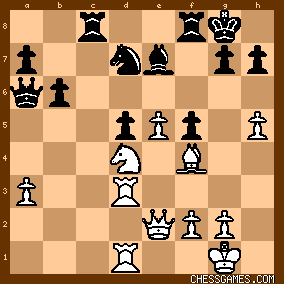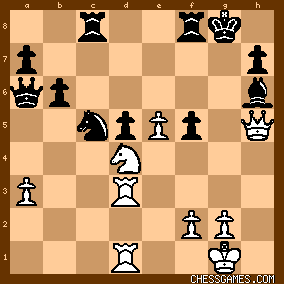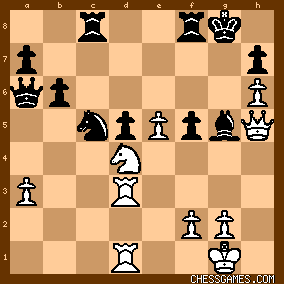|
< Earlier Kibitzing · PAGE 2 OF 2 ·
Later Kibitzing> |
| Feb-28-16 | | rookienight: Isn't 35 Qg7 mate? |
|
| Feb-28-16 | | morfishine: Marvelous, marvelous game, a real treat to see high quality games like this (from the 'modern' era) for the first time |
|
| Feb-28-16 | | erbalaji: 34 by black is a check. So 35 Qg7 is not legal! |
|
| Feb-28-16 | | rookienight: thanks! |
|
| Feb-28-16 | | The Kings Domain: Tough and challenging puzzle, love it. Good game, good attack countered by good defense. I thought at first it would end in mate or close to it, but white's pawn advantage in the end sealed black's fate. |
|
| Feb-28-16 | | patzer2: Extremely complicated Sunday puzzle where I missed the game continuation 26. Bxg5!!  to to  which gives White the strongest winning chances. which gives White the strongest winning chances. An interesting alternative is 26. Qxd5+!? Kh8 27. e6! Nxd3 28. Qe7! = where Black has to tread carefully to avoid losing and at best seems to survive only with a clever drawing resource. For an early Black improvement in the opening, I slightly prefer 14...Bxd3 = (as in I Sokolov vs Bologan, 2004) or 17...Bxg5 = (transposing back to the same Sokolov vs. Bologan game) to reduce the complications and simplify Black's defense. Here's my move-by-move look with Deep Fritz 15:
[Event "7th Essent"]
[Site "Hoogeveen NED"]
[Date "2003.10.17"]
[Round "5"]
[White "Ivan Sokolov"]
[Black "Judit Polgar"]
[Result "1-0"]
[ECO "E12"]
[WhiteElo "2695"]
[BlackElo "2722"]
[PlyCount "83"]
[EventDate "2003.10.12"]
1. d4 Nf6 2. c4 e6 3. Nf3 b6 4. Nc3 Bb7 5. a3 d5 6. cxd5 Nxd5 7. Qc2 Nxc3 8.
bxc3 Be7 9. e4 O-O 10. Bd3 c5 11. O-O Qc8 12. Qe2 Ba6 13. Rd1 Rd8 14. h4 cxd4 (
Here the computers slightly prefer 14... Bxd3 = as in I Sokolov vs Bologan, 2004) 15. cxd4 Bxd3 16. Rxd3 Nd7 17. Bg5 f6 (
An alternative I like here is 17... Bxg5 = transposing back to I Sokolov vs Bologan, 2004) 18. Bf4 Qb7 19. h5 Rac8 20. Rad1
Qa6 21. e5 f5 22. d5 exd5 23. Nd4 Rf8 24. Qf3 Nc5 25. h6 g5 26. Bxg5 (26. Qxd5+
Kh8 27. e6 Nxd3 28. Qd7 Rce8 (28... Bf6 29. Bxg5  ) 29. Bxg5 Ne5 30. Qc7 Ng6
31. Nxf5 Qa5 32. Bxe7 Nxe7 33. Nxe7 Qg5 34. Rd5 Qxe7 35. Rd7 Qf6 36. Rxh7+ Kg8
37. Rg7+ Kh8 38. Rh7+ Kg8 39. Rg7+ Kh8 40. Rh7+ Kg8 =) 26... Bxg5 27. Qh5 Bf4
(27... Nxd3 $4 28. Qxg5+ Kf7 29. e6+ Ke8 30. Nxf5 Rxf5 31. Qxf5 Rc7 32. Qxd5
Qc4 33. Qd6 Qf4 34. Qxd3 Ke7 35. Qd8+ Kxe6 36. Re1+ Kf5 37. Qd5+ Kg4 38. g3 Qf5
39. Re4+ Kg5 40. Re5 ) 29. Bxg5 Ne5 30. Qc7 Ng6
31. Nxf5 Qa5 32. Bxe7 Nxe7 33. Nxe7 Qg5 34. Rd5 Qxe7 35. Rd7 Qf6 36. Rxh7+ Kg8
37. Rg7+ Kh8 38. Rh7+ Kg8 39. Rg7+ Kh8 40. Rh7+ Kg8 =) 26... Bxg5 27. Qh5 Bf4
(27... Nxd3 $4 28. Qxg5+ Kf7 29. e6+ Ke8 30. Nxf5 Rxf5 31. Qxf5 Rc7 32. Qxd5
Qc4 33. Qd6 Qf4 34. Qxd3 Ke7 35. Qd8+ Kxe6 36. Re1+ Kf5 37. Qd5+ Kg4 38. g3 Qf5
39. Re4+ Kg5 40. Re5  (#8, Deep Fritz 15 @ 24 depth)) (27... Bxh6 28. Rh3
Qa4 29. Rd2 Qd7 (29... Rc7 30. Qxh6 Rg7 31. Rh5 Qxa3 32. Kh2 Qc3 33. Rg5 Rxg5
34. Qxg5+ Kh8 35. Qe7 Kg8 36. Rd1 Ne4 37. Ne6 Qxe5+ 38. f4 Qf6 39. Qxf8+ Qxf8
40. Nxf8 Kxf8 41. Rxd5 (#8, Deep Fritz 15 @ 24 depth)) (27... Bxh6 28. Rh3
Qa4 29. Rd2 Qd7 (29... Rc7 30. Qxh6 Rg7 31. Rh5 Qxa3 32. Kh2 Qc3 33. Rg5 Rxg5
34. Qxg5+ Kh8 35. Qe7 Kg8 36. Rd1 Ne4 37. Ne6 Qxe5+ 38. f4 Qf6 39. Qxf8+ Qxf8
40. Nxf8 Kxf8 41. Rxd5  (+1.97 @ 22 depth, Deep Fritz 15)) 30. Qxh6 f4 31.
Rh5 Ne4 32. Rd1 Qg7 33. Qxg7+ Kxg7 34. Ne6+ Kg6 35. Rh4 Nc3 36. Re1 Rfe8 37.
Nxf4+ Kg7 38. e6 Rc4 39. Re3 Ne4 40. Nxd5 Rxe6 41. f3 Rc1+ 42. Kh2 Nc5 43. Rxe6
Nxe6 44. Ra4 b5 45. Rxa7+ Kg6 46. g4 Rd1 47. Rd7 Ra1 48. f4 Nc5 49. Ra7 Ne4 50.
Kg2 Ra2+ 51. Kh3 Rd2 52. Rd7 Kh6 53. Nf6 Rxd7 54. Nxd7 (+1.97 @ 22 depth, Deep Fritz 15)) 30. Qxh6 f4 31.
Rh5 Ne4 32. Rd1 Qg7 33. Qxg7+ Kxg7 34. Ne6+ Kg6 35. Rh4 Nc3 36. Re1 Rfe8 37.
Nxf4+ Kg7 38. e6 Rc4 39. Re3 Ne4 40. Nxd5 Rxe6 41. f3 Rc1+ 42. Kh2 Nc5 43. Rxe6
Nxe6 44. Ra4 b5 45. Rxa7+ Kg6 46. g4 Rd1 47. Rd7 Ra1 48. f4 Nc5 49. Ra7 Ne4 50.
Kg2 Ra2+ 51. Kh3 Rd2 52. Rd7 Kh6 53. Nf6 Rxd7 54. Nxd7  (+1.76 @ 22 depth,
Deep Fritz 15).) 28. Rf3 Bxe5 29. Nxf5 Qb7 (29... Kh8 30. Ne7 Bb2 31. Nxc8
Qxc8 32. Qxd5 Rg8 33. Rd2 Ba1 34. Rf7 Ne6 35. Qd7 Qxd7 36. Rdxd7 Ng5 37. Rf5 a5
38. Re7 a4 39. f4 Nf3+ 40. Kh1 Nd2 41. Rff7 Rc8 42. Rxh7+ Kg8 43. g4 (+1.76 @ 22 depth,
Deep Fritz 15).) 28. Rf3 Bxe5 29. Nxf5 Qb7 (29... Kh8 30. Ne7 Bb2 31. Nxc8
Qxc8 32. Qxd5 Rg8 33. Rd2 Ba1 34. Rf7 Ne6 35. Qd7 Qxd7 36. Rdxd7 Ng5 37. Rf5 a5
38. Re7 a4 39. f4 Nf3+ 40. Kh1 Nd2 41. Rff7 Rc8 42. Rxh7+ Kg8 43. g4  (+2.
63 @ 20 depth, Deep Fritz 15).) 30. Rxd5 Rce8 31. Qg5+ Kh8 32. Rxe5 Rxe5 33.
Ne7 Re1+ 34. Kh2 Qb8+ 35. Rg3 Rxe7 36. Qxe7 Ne6 37. Qxe6 Qf4 38. a4 a6 39. Qxb6
Rb8 40. Qe3 Qh4+ 41. Rh3 Qf6 42. Qc3 1-0 (+2.
63 @ 20 depth, Deep Fritz 15).) 30. Rxd5 Rce8 31. Qg5+ Kh8 32. Rxe5 Rxe5 33.
Ne7 Re1+ 34. Kh2 Qb8+ 35. Rg3 Rxe7 36. Qxe7 Ne6 37. Qxe6 Qf4 38. a4 a6 39. Qxb6
Rb8 40. Qe3 Qh4+ 41. Rh3 Qf6 42. Qc3 1-0
P.S.: Copy and paste to a Chess program to view the Deep Fritz 15 analysis here. It should save some processing and calculating time on most PCs as it took quite a while for Fritz to find some of these lines on a quad core i7 running at 3.6 GHZ with 16 GB RAM. |
|
| Feb-28-16 | | mel gibson: My computer is agreeing.
26 Bxg5 score for white + 0.71 Depth 20.
That's not even a one pawn advantage so it's anyone's game. |
|
| Feb-28-16 | | WorstPlayerEver: Nice, but 32. Ne7 Bc3 33. Re5 Ne6 34. Re6 is much stronger than 32. Re5 Why so greedy? |
|
| Feb-28-16 | | RandomVisitor: GMs sometimes miss better tactical moves in complicated positions, for example after 23...Rf8, compare with the move played, 24.Qf3
click for larger viewKomodo-9.3-64bit:
+1.44/31 24.Bh6 Nc5 25.Rg3 Qxe2 26.Rxg7+ Kh8 27.Nxe2 Rfe8 28.Rf7 Ne6 29.Nd4 Nxd4 30.Rxd4 Rc6 31.Bd2 Bxa3 32.Rxd5 a5 33.Rdd7 h6 34.Rh7+ Kg8 35.Rdg7+ Kf8 36.Rb7 Kg8 37.Bxh6 Re7 38.Rhxe7 Bxe7 39.Be3 Re6 40.Bxb6 a4 41.Bd4 Kf8 42.f4 Rh6 43.Kf2 Ke8 44.g4 fxg4 45.Kg3 Rxh5 46.Kxg4 Rh4+ 47.Kf5 a3 +1.39/31 24.h6 g6 25.Qf3 Qb7 26.Nb5 Nc5 27.Rxd5 Rfe8 28.Qc3 Bf8 29.Be3 Ne4 30.Qb2 Qc6 31.Nxa7 Qc2 32.Qxc2 Rxc2 33.Rd8 Rxd8 34.Rxd8 Kf7 35.Rd7+ Be7 36.Rb7 g5 37.Nb5 Nc5 38.Rxb6 f4 39.Bd4 Ne6 40.Rb7 Nd8 41.Rd7 Ke6 42.Ra7 Nc6 43.Rb7 g4 44.Kh2 Kd5 45.a4 Nxd4 46.Rxe7 Nxb5 47.axb5 |
|
| Feb-28-16 | | WorstPlayerEver: @RandomVisitor
I beg to differ. While it is no matter of tactics, but of strategy! After 24. Qf3 the game is finished in 10 moves, theoretically. |
|
| Feb-28-16 | | thegoodanarchist: <RandomVisitor: GMs sometimes miss better tactical moves in complicated positions, for example after 23...Rf8, compare with the move played, 24.Qf3> The good news for GM Sokolov is that he won anyway. Wouldn't it be terrible to draw or lose, go back to your room, and have your engine show you where you threw away a win? (I know from experience the answer is yes!) |
|
| Feb-28-16 | | FabrikaLaHun: Here's what GM Sokolov himself says after 27.Qh5
<This is the position I had to evaluate when I opted for the intuitive sacrifice started with h6! It was impossible for me to calculate everything, but I had a number of reasons to trust my intuition: A) the attackers vs defenders ratio is overwhelmingly on my side (Black's Qa6, Nc5, and Rc8 do not really participating in the defence of his king); B) Black's f5-pawn will also fall, so, apart from the h7-pawn, the pawn defences in front of Black's castled king have been removed, which is always a strong argument for the attacking side; C) White's h6-pawn, the Qh5 and the forthcoming Nf5, Rf3 (g3) combination will create a mating net around the black king ; • D) White's rook on d3 (which Black has no time to collect) is excellently placed and will enter the fray via either g3 or f3. So no, I could not calculate everything, but I had plenty of reasons to believe my intuition to be right.> http://en.chessbase.com/post/interv... |
|
| Feb-28-16 | | Longview: <Patzer2> It seems we chose the same path, though I saw Bxg5, I was trying to pin the Bishop to the king, and my calculations showed less promise than the game played where the bishop is sacked in favor of the rook. |
|
| Feb-28-16 | | morfishine: <rookienight> On your question: "Isn't 35.Qg7 mate?" No, White is in check
***** |
|
Feb-28-16
 | | Jimfromprovidence: I got lost after 27...Bxh6.

click for larger view I can see 28 Rh3 or 28 Rg3+ following but that's it. |
|
| Feb-28-16 | | Patriot: This is really complicated! Black has major threats but the kingside looks much weaker and there's a pawn on h6 which creates a big weakness on g7. After spending some time on this I chose 26.Bxg5 Bxg5 27.Qh5 and thought on 27...Ne4 28.Rg3 is quite strong.
The game took a completely different turn and it's not surprising because it is so involved. Before considering the line up to 27.Qh5, I first went through some other candidates like 26.Qxd5+, 26.Nxf5, and 26.Bxg5 Bxg5 27.Qg3 Ne4 or 27.Qxd5+ Kh8 28.Rg3. I think "insane" is accurate. |
|
| Feb-28-16 | | Patriot: <FabrikaLaHun> Thanks for sharing Sokolov's thoughts! Usually everyone thinks the player was amazing to calculate everything through but he was amazing instead for his intuitiveness. I'll bet that happens quite often of the best players. |
|
| Feb-28-16 | | Ayaend: The 33th move is also insane !! |
|
| Feb-28-16 | | devere: After 26.Bxg5 Bxg5 27.Qh5

click for larger view
Black has at least 5 reasonable defensive moves to consider, 27...Ne4 or b5 or Bd8 or Bxh6 or the move actually played, Bf4. It wasn't possible to calculate everything, so Grandmaster Sokolov relied on his intuition, and in this game he was gloriously correct. It's a nice problem, and a very fine game. |
|
| Feb-28-16 | | agb2002: White is one pawn down.
Black threatens 26... Nxd3 and 26... gxf4.
I didn't have time for this puzzle today but I think I'd play 26.Qxd5+ with ideas like Ne6 or Rg3. |
|
| Feb-28-16 | | Dr. J: <Patriot: 26.Bxg5 Bxg5 27.Qh5 and [I] thought 27...Ne4 28.Rg3 is quite strong.> Black can play 28...Nxg3 29.Qxg5+ Kf7 30.Qf6+ Ke8 31.Qe6+ Kd8 32.Qd6+ Ke8 and now both 33.Nc6 Ne2+ 34.Kh2 Rxc6 and 33.fxg3 Qb7 34.Nxf5 look unclear, though not unpleasant for White, who has at least a draw. Can he win it? I think 27...Ne4 28.f3 is refuted by 28...Qxd3!! 29.Rxd3 (29.fxe4 Be3+ 30.Kh2 Bf4+ 31.Kh1 Qxd1+ 32.Qxd1 Rc1 wins.) Rc1+ 30.Kh2 Bf4+ 31.g3 Nxg3 winning the White Queen. (I am rather pleased with myself for spotting this variation.) <mel gibson: My computer is agreeing.
26 Bxg5 score for white + 0.71 Depth 20.> What does it give as the best defense? <Patriot: This is really complicated!> |
|
| Feb-28-16 | | devere: Here's what might have happened if Polgar had taken the exchange before playing g5: 25...Nxd3 26.Rxd3 g5 27.Qxd5+ Kh8 28.Ne6 gxf4 29.Qd7 Rfe8 30.Nd8!! Rcxd8 31.Qxe7 and checkmate is inevitable.

click for larger view |
|
| Feb-29-16 | | Moszkowski012273: Yeah 24.Qf3... was incorrect. |
|
| Mar-02-16 | | Moszkowski012273: 33.Ne7 - not so impressive. 32.Ne7! - impressive! (As was already pointed out) |
|
Dec-11-21
 | | plang: Ian Rogers on 13..Rd8?!:
"White has recently been scoring well after 13..cxd 14 cxd..Bxd3 15 Rxd3..Nd7 16 e5, so Polgar tries a finesse, delaying the development of her knight until White has committed himself in the centre. After e5 the knight may be better placed on c6. However Polgar's idea is probably too subtle. As Sokolov shows, White has a number of constructive moves and Black will eventually have to put the knight on d7 in any case."17..f6?! weakened the kingside; better was 17..Bxg5 18 Nxg5..h6 19 Qh5 with interesting play. 20..b5 with the idea of ..Nb6 was suggested as a more active continuation. 22..Nc5 23 d6..Nxd3 24 Qxd3..Qxd3 25 Rxd3..Rd7 (25..Bf8? 26 Ng5) 26 Nd4..Kf7 27 dxe..Rc4 28 Rg3..Rxe7 29 Bg5 would have favored White. White would have won after 23..Nc5 24 24 Nxf5..Bf8 25 Qg4!..Nxd3 26 Nh6+..Kh8 27 Nf7+..Kg8 28 Qe6 and mates. Sokolov after 25 h6!:
"This move prepares the scene for a piece sacrifice. Naturally I could not calculate things till the end, but I did see a lot of promising lines and with Black's exposed king, his limited number of defenders and the Black queen stranded on a6, the logic of the attack should be on the White side." 32 Ne7!..Bb2 33 Re5! would also have been winning. 35 g3? Ne6 would actually have won for Black. 38..Rf7 would have held out longer. Voted the 3rd best game in Informant 89 though I think that undervalues how beautiful the game is. |
|
 |
|
< Earlier Kibitzing · PAGE 2 OF 2 ·
Later Kibitzing> |





